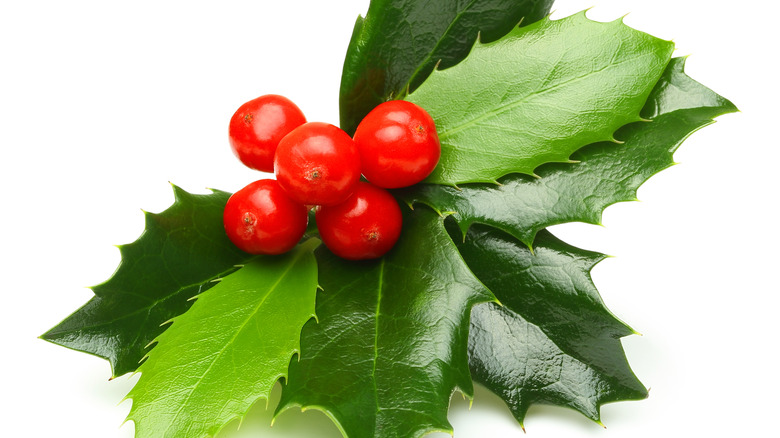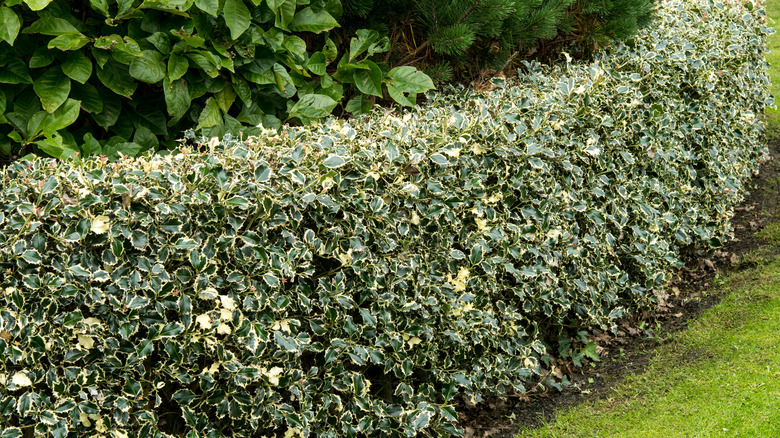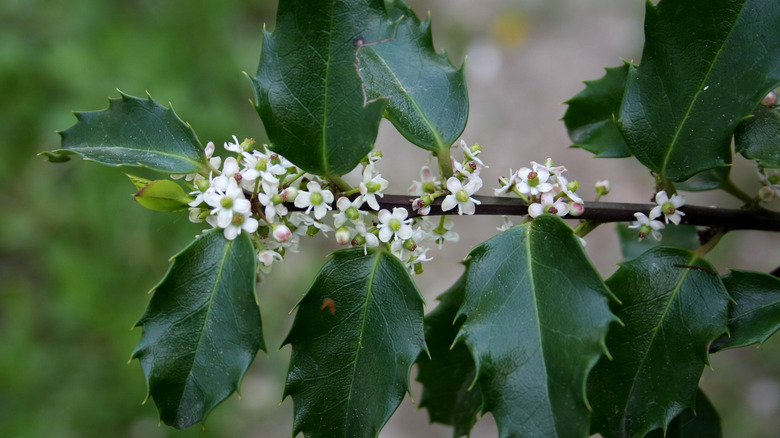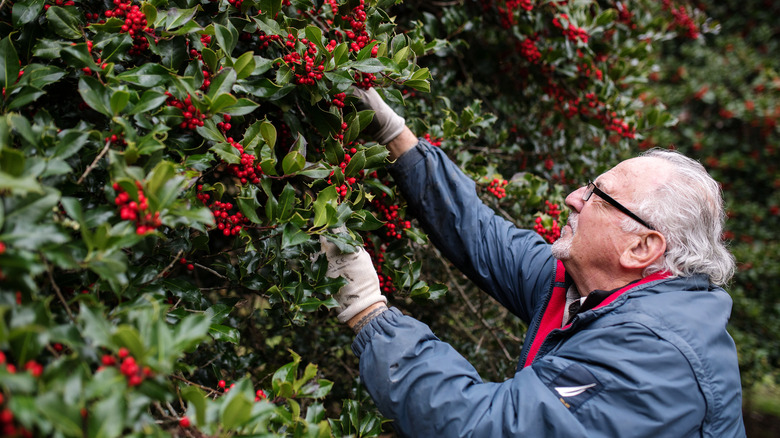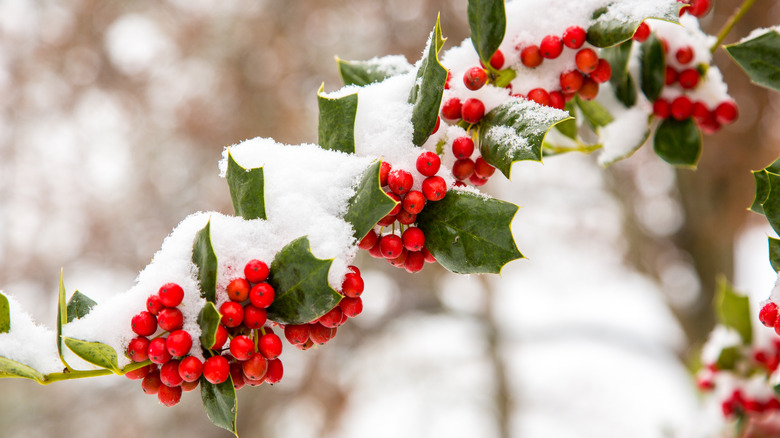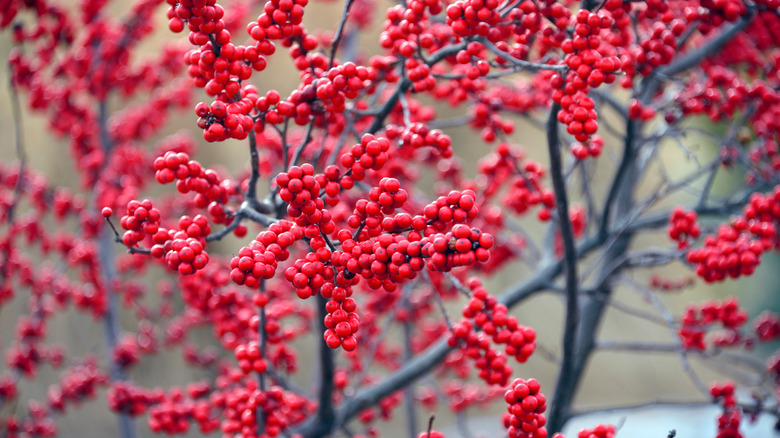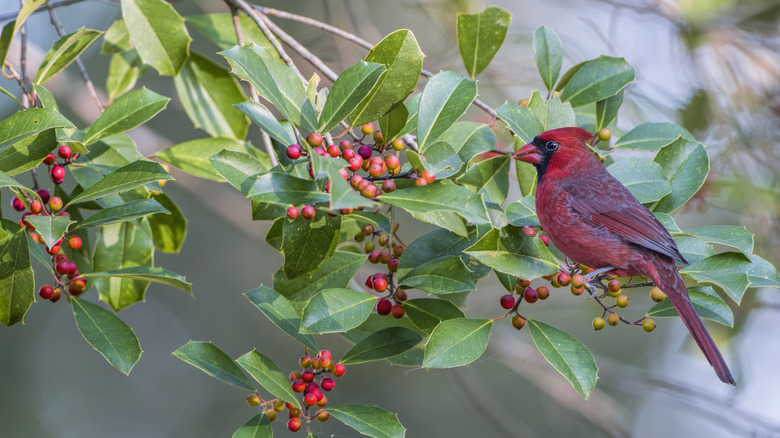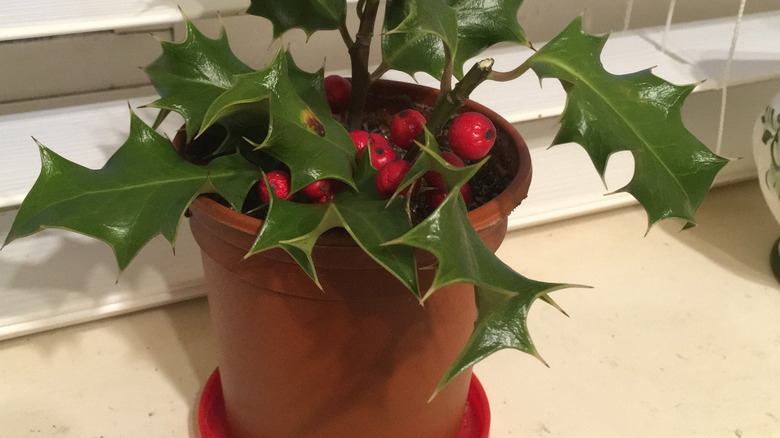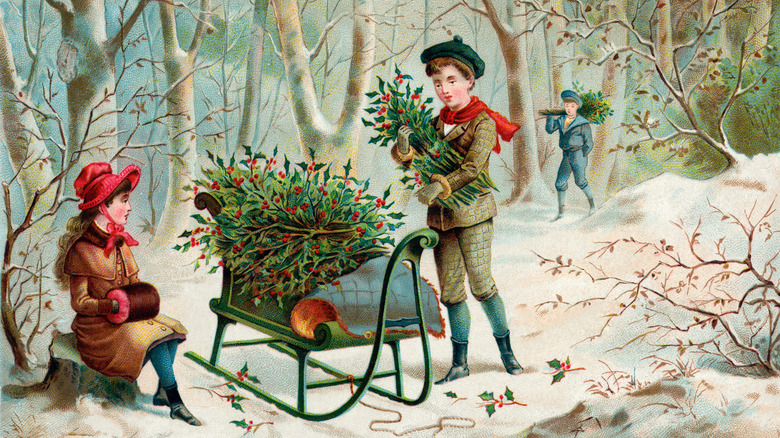How To Successfully Grow And Care For Holly Bushes
Evergreen and versatile, traditional holly bushes are instantly recognizable by their signature bright red berries and glossy green leaves. Holly, also known by its genus, Ilex, is most often celebrated and used for decoration indoors and out during the Christmas season, per Garden Design. This plant can also help beautify your garden in all seasons.
Clemson Cooperative Extension Home & Garden Information Center indicates there are hundreds of types of holly native to areas such as China, Japan, and England, with some varieties native to the United States as well. The holly is most often a tree or shrub but can also climb like a vine. In the U.S., different varieties of holly will thrive in zones 3 to 10, with growth slightly slower in the south and southeast due to the warmer temperatures.
Holly can grow as large as 80 feet tall and about 50 feet in diameter. Their dark green leaves are oval with a leathery texture that end with a barb or spike. The leaves have a firm spine and grow to be about a half-inch to several inches long. Some varieties have a smoother leaf that looks like boxwood. Leaves can be green, dark blue, variegated, or even gold. Traditionally berries are red but also come in pink, yellow, white, and black. The holly has a long history of folklore and stories, per Tyler Arboretum. The plant was revered by the Romans, Celts, and Druids, and it also figures prominently in legends in Asian cultures.
How to use holly bushes in the garden
Holly is considered an ornamental plant, meaning its job is to look good no matter where you plant it in the garden or indoors. Unlike some shrubs that tend toward a particular shape and size, holly is a surprisingly flexible plant that can be used in the garden and landscaping in many ways. Better Homes & Gardens indicates holly works well as a hedge in a variety of heights and can be kept flat and even by regular trimming. It also works as a companion to other evergreens –- plant it next to or under pines. It also looks terrific surrounded by ivy, or a wall covered in ivy, as both plants remain green throughout the year.
Holly creates a kind of green screen, perfect for hiding unsightly elements in the yard or for privacy. You can also use a cluster of plants as foundation bushes, creating a green line at the base of your house. Smaller varieties will fit into a large pot or container. Remember holly can grow in many different shapes and sizes, so be sure to read tags or consult with a garden center before bringing home a bush too big or too small for your yard.
How to grow holly bushes
Unlike most shrubs, holly is dioecious, which means that in order to produce berries, you need both male and female plants. The plants need to be in fairly close proximity, within 200 yards or closer. Gardening Know How describes how female plants must be pollinated by a male holly to produce the bright bursts of color the berries give the plant. Male holly bushes do not produce berries at all. Female holly bushes planted with no male nearby will not produce berries either.
It's very difficult to determine if holly is male or female just by looking at the leaves, explains Gardening Know How. Both genders bloom with fragrant, small white flowers in spring. The flowers of the male holly plant have a more pronounced stamen. A reputable nursery or garden supply house will carry some varieties in pairs, such as China Boy and China Girl or Blue Prince and Blue Princess. Note that there are some rare varieties of holly that don't have a berry at all, so do a little research on the color, shape, and size of holly you want.
How to plant holly bushes
The National Gardening Association says that holly bushes prefer to be planted in soil with good drainage that's moderately acidic. Plant in a part of the yard that receives some full sun, though holly will also grow in dappled shade. The more sunlight the plant receives, the more berries it will have. Holly plants prefer slightly dry conditions, and they are drought tolerant.
Holly will grow from seeds, but it will take nearly a year to grow a root system strong enough to support the plant. A more typical way to add holly to your yard is to buy a year-old or older plant with a root ball firmly established. Gardener's Path says to loosen dirt from the root ball and plant in a hole slightly wider than the root ball and level with the surrounding surface. Fill in with soil and composted material and water moderately every day for several weeks.
The best time to plant is in spring, when all danger of frost is past, per Better Homes & Gardens. Remember that holly can grow to be up to 60 feet tall, and once established, they don't like to be transplanted. Carefully measure the area where you want to plant, and then check the diameter of the plant you purchase so once the plants mature, they're neither too far apart nor too close together. Space the plants 10 to 20 feet apart. Fertilize with a product made for acid-loving evergreens once a year.
How to care for holly bushes
Holly is a hardy plant, so once established, it doesn't need a lot of attention to thrive, and it will produce foliage and berries for many years. Note that most varieties don't produce any berries in the first few years. Most holly bushes need to be 3 years old to flower and grow berries.
As mentioned, most holly types need male and female plants near each other to produce those colorful berries, and only the females will produce berries. Gardener's Path indicates you can mix and match the varieties of holly if you want, but the trick is to be sure they flower at the same time, or no berries will be forthcoming.
Because of their leathery texture, holly bushes are typically deer resistant. Clemson Cooperative Extension Home and Garden Information Center describes the diseases affecting holly, including root rot, which is caused by fungi in the soil that's too damp and too warm. Tar spot is also caused by a fungus and can be remedied by removing damage and improving air circulation. Potential pests include southern red mites, leaf miners, and scale, all of which can be addressed with pesticides, removing the pests by hand, or removing affected foliage. However, if a plant is planted in the correct spot, with ample sunlight, good drainage, and no stress, they tend not to become infected with disease or affected by pests.
Varieties of holly
With hundreds of varieties available, consider what will grow best in your climate and where to place your holly for maximum beauty. With such a wide diversity of sizes, be sure to plant holly bushes where they fit in your yard. Consider too what you want to do with the holly -– many people craft wreaths and swags for indoor use or include cuttings with flower arrangements. Some varieties are best left outdoors to create visual excitement in an otherwise bleak winter landscape. Clemson Cooperative Extension Home & Garden Information Center describes some popular types of holly.
- English Holly (Ilex aquifolium) has dark green shiny leaves and bright red berries.
- American Holly (Ilex opaca) also has dark green, spiny leaves and red berries, but the leaves are matte and have no gloss to their appearance. This is the traditional holly depicted in crafts and on Christmas cards.
- American Holly 'Yellow Berry' (Ilex opaca) produces yellow berries, making for a truly unique plant in your garden.
- Inkberry Holly (Ilex glabra) has a smooth, oval leaf with no spikes and produces black-colored berries.
- Winterberry (Ilex verticillata) has dark green leaves and large, red berries. Unlike other holly types, Winterberry drops its leaves, leaving spectacular crimson berries that last all winter.
- Chinese Holly (Ilex cornuta) has dark, smooth leaves and produces berries, but unlike other holly plants, it does not need a male/female pairing to produce them.
Is holly toxic?
Unfortunately, the holly's beautiful berries that offer a stunning winter landscape are toxic to humans, dogs, and cats. According to the North Carolina Extension Gardener, eating the berries can cause nausea, vomiting, and diarrhea. When bringing holly into the house to decorate, remember that the berries dry out quickly and fall to the ground, where children and pets can find them. However, wild birds can and do eat holly, and berries are an important source of food during the winter months.
The holly leaves are not toxic but aren't necessarily edible either. The leaves are not toxic to touch, but depending on the variety you have, the spiky leaves can be very sturdy and difficult to work with. Wearing long, protective sleeves and gloves when pruning or trimming is recommended.
There is one edible member of the holly family, Yerba Mate (Ilex paraguariensis). The Spruce describes how to cultivate and use this plant native to subtropical South American countries. Unlike hardy holly varieties, Yerba Mate should be grown indoors unless your climate is extremely hot and humid and doesn't experience frost. The plant's caffeine-laden leaves are brewed or used as a powder to make a popular tea-like beverage. However, do not attempt to make a beverage from the leaves of the average holly bush.
Growing potted holly indoors
Who can resist those clever potted "starter plants" in 4 or 6-inch pots sometimes spotted at grocery stores and farmers' markets around Christmastime? The good news is that with some insight and care, holly can grow indoors. According to The Indoor Garden, like many other house plants, holly prefers sunny spaces filled with indirect light, loamy soil, moderate watering, and moderate temperatures.
The biggest challenge to growing holly indoors is not potting or repotting but pollinating. Remember that holly needs a male and female plant to create berries. In spring, when the holly gives off flowers, setting the potted plant outside will allow insects to do the work of pollination. If outdoor access isn't possible, take a cotton swab or small paintbrush and remove pollen from the stamen of the male to the pistol of the female, the protruding yellow stems in the middle of the flower. Anything labeled "self-pollinating" probably has a male and female potted together to save you a step and have the plant give off flowers as well as berries.
Holly legends
We mentioned that holly figures prominently in folklore from Ireland to Japan, and some of the legends and stories surrounding holly are fascinating. Tyler Arboretum gives a quick tour of beliefs about holly through the ages. Ancient Romans believed that holly would repel lightning if planted next to a house or barn. Celts and Druids thought of holly as a symbol of eternal life since it stayed green throughout the year. They, too, believed holly branches inside the house would protect it from lightning and more; they believed that cutting down a holly tree brought bad luck, per Trees for Life.
For Christians, throughout European history, holly has been featured as a plant representing the story of Jesus, the spikes on the holly plant representative of the crown of thorns, and the berries his blood. Carols such as "The Holly and the Ivy" refer to this, explains Celebrating Holidays. Though written in the 19th century, the tune refers to incorporating holly in interior décor, a practice that dates from the Middle Ages. By the 18th and 19th centuries, the use of holly was prevalent as a Christmas decoration in houses and churches. To this day, many communities customarily decorate with holly at Christmas and throughout the dark winter months.

